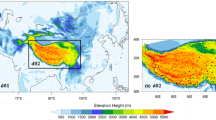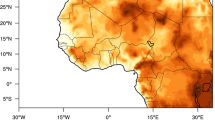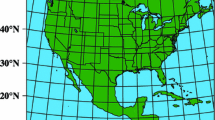Abstract
Kiremt-season (June–September) precipitation provides a significant water supply for Ethiopia, particularly in the central and northern regions. The response of Kiremt-season precipitation to climate change is thus of great concern to water resource managers. However, the complex processes that control Kiremt-season precipitation challenge the capability of general circulation models (GCMs) to accurately simulate precipitation amount and variability. This in turn raises questions about their utility for predicting future changes. This study assesses the impact of climate change on Kiremt-season precipitation using state-of-the-art GCMs participating in the Coupled Model Intercomparison Project Phase 5. Compared to models with a coarse resolution, high-resolution models (horizontal resolution <2°) can more accurately simulate precipitation, most likely due to their ability to capture precipitation induced by topography. Under the Representative Concentration Pathway (RCP) 4.5 scenario, these high-resolution models project an increase in precipitation over central Highlands and northern Great Rift Valley in Ethiopia, but a decrease in precipitation over the southern part of the country. Such a dipole pattern is attributable to the intensification of the North Atlantic subtropical high (NASH) in a warmer climate, which influences Ethiopian Kiremt-season precipitation mainly by modulating atmospheric vertical motion. Diagnosis of the omega equation demonstrates that an intensified NASH increases (decreases) the advection of warm air and positive vorticity into the central Highlands and northern Great Rift Valley (southern part of the country), enhancing upward motion over the northern Rift Valley but decreasing elsewhere. Under the RCP 4.5 scenario, the high-resolution models project an intensification of the NASH by 15 (3 × 105 m2 s−2) geopotential meters (stream function) at the 850-hPa level, contributing to the projected precipitation change over Ethiopia. The influence of the NASH on Kiremt-season precipitation becomes more evident in the future due to the offsetting effects of two other major circulation systems: the East African Low-level Jet (EALLJ) and the Tropical Easterly Jet (TEJ). The high-resolution models project a strengthening of the EALLJ, but a weakening of the TEJ. Future changes in the EALLJ and TEJ will drive this precipitation system in opposite directions, leading to small or no net changes in precipitation in Ethiopia.









Similar content being viewed by others
Notes
The TEJ index is defined as the intensity of 200 hPa easterly wind with in the 30°E–70°E and 7°N–20°N domain. The EALLJ is defined as the intensity of 850 hPa southerly wind averaged over the domain of 35°E–55°E, 5°S–10°N. The NASH intensity is defined as the maximum of 850 hPa geopotential height over the subtropical North Atlantic basin.
We also quantified the NASH intensity change using streamfunction. The results show that the streamfunction will increase by 3 × 105 m2 s−2 under RCP 4.5 scenario compared to Historical run, indicating an intensification of the NASH in a warmer climate.
References
Bell JL, Sloan LC, Snyder MA (2004) Regional changes in extreme climatic events: a future climate scenario. J Clim 17:81–87
Chen M, Xie P, Janowiak JE, Arkin PA (2002) Global land precipitation: a 50-yr monthly analysis based on gauge observations. J Hydrometeorol 3:249–266
CIA (2014) The World Factbook: Ethiopia. US Central Intelligence Agency, Washington, USA
Diro GT, Grimes DIF, Black E (2011a) Teleconnections between Ethiopian summer rainfall and sea surface temperature: part I—observation and modelling. Clim Dyn 37:103–119
Diro GT, Grimes DIF, Black E (2011b) Large scale features affecting Ethiopian rainfall. In: Williams CJR, Kniveton DR (eds) African Climate and Climate Change. Springer, Berlin, pp 13–50
Evangelista P, Young N, Burnett J (2013) How will climate change spatially affect agriculture production in Ethiopia? Case studies of important cereal crops. Clim Change 119:855–873
Feser F, Rockel B, Storch HV, Winterfeldt JRG, Zahn M (2011) Regional climate models add value to global model data. Bull Am Meteorol Soc 92:1181–1192
Gissila T, Black E, Grimes DIF, Slingo JM (2004) Seasonal forecasting of the Ethiopian summer rains. Int J Climatol 24:1345–1358
Harris I, Jones PD, Osborn TJ, Lister DH (2014) Updated high-resolution grids of monthly climatic observations—the CRU TS3. 10 Dataset. Int J Climatol 34:623–642
Holton JR (ed) (2004) An introduction to dynamic meteorology, vol 48. Academic Press, New York
Hu Z-Z, Huang B (2006) Air–sea coupling in the North Atlantic during summer. Clim Dyn 26:441–457
Hulme M, Tosdevin N (1989) The tropical easterly jet and Sudan rainfall: a review. Theor Appl Climatol 39:179–187
Joly M, Voldoire A, Douville H, Terray P, Royer J-F (2007) African monsoon teleconnections with tropical SSTs: validation and evolution in a set of IPCC4 simulations. Clim Dyn 29:1–20
Kalnay E et al (1996) The NCEP-NCAR 40-year reanalysis project. Bull Am Meteorol Soc 77:437–471
Korecha D, Barnston AG (2007) Predictability of June–September rainfall in Ethiopia. Mon Weather Rev 135:628–650
Kushnir Y, Robinson WA, Bladé I, Hall NMJ, Peng S, Sutton R (2002) Atmospheric GCM response to extratropical SST anomalies: synthesis and evaluation. J Clim 15:2233–2256
Kushnir Y, Seager R, Ting M, Naik N, Nakamura J (2010) Mechanisms of tropical Atlantic SST influence on North American precipitation variability. J Clim 23:5610–5628
Li W, Fu R, Juarez RIN, Fernandes K (2008) Observed change of the standardized precipitation index, its potential cause and implications to future climate in the Amazon region. Philos Trans R Soc B: Biol Sci 363:1767–1772
Li W, Li L, Fu R, Deng Y, Wang H (2011) Changes to the North Atlantic subtropical high and its role in the intensification of summer rainfall variability in the southeastern United States. J Clim 24:1499–1506
Li W, Li L, Ting M, Liu Y (2012) Intensification of Northern Hemisphere subtropical highs in a warming climate. Nat Geosci 5:830–834
Li L, Li W, Deng Y (2013) Summer rainfall variability over the Southeastern United States in the 21st century as assessed by the CMIP5 models. J Geophys Res Atmos 118:340–354
Megersa B, Markemann A, Angassa A, Ogutu JO, Piepho H-P, Zaráte AV (2014) Impacts of climate change and variability on cattle production in southern Ethiopia: perceptions and empirical evidence. Agric Syst 130:23–34
Moss RH et al (2010) The next generation of scenarios for climate change research and assessment. Nature 463:747–756
Nicholson SE, Grist JP (2003) The seasonal evolution of the atmospheric circulation over West Africa and equatorial Africa. J Clim 16:1013–1030
Nicholson SE, Kim J (1997) The relationship of the El Nino-Southern oscillation to African rainfall. Int J Climatol 17:117–135
Otieno VO, Anyah RO (2013) CMIP5 simulated climate conditions of the Greater Horn of Africa (GHA). Part 1: contemporary climate. Clim Dyn 41:2081–2097
Pielke RAS (2002) Mesoscale meteorological modeling, 2nd edn. Elsevier, Amsterdam
Rodríguez-Fonseca B et al (2015) Variability and predictability of West African droughts: a review of the role of sea surface temperature anomalies. J Clim (in press) doi:10.1175/JCLI-D-1114-00130.00131
Rowell DP (2003) The impact of Mediterranean SSTs on the Sahelian rainfall season. J Clim 16:849–862
Rudolf B, Becker A, Schneider U, Meyer-Christoffer A, Ziese M (2010) GPCC status report December 2010 (on the most recent gridded global data set issued in fall 2010 by the Global Precipitation Climatology Centre (GPCC))
Segele ZT, Lamb PJ (2005) Characterization and variability of Kiremt rainy season over Ethiopia. Meteorol Atmos Phys 89:153–180
Segele ZT, Lamb PJ, Leslie LM (2009a) Seasonal-to-interannual variability of Ethiopia/Horn of Africa Monsoon. Part I: associations of Wavelet-Filtered Large-Scale atmospheric circulation and global sea surface temperature. J Clim 22:3396–3421
Segele ZT, Lamb PJ, Leslie LM (2009b) Large-scale atmospheric circulation and global sea surface temperature associations with Horn of Africa June–September rainfall. Int J Climatol 29:1075–1100
Segele ZT, Richman MB, Leslie LM, Lamb PJ (2015) Seasonal-to-interannual variability of ethiopia/horn of Africa monsoon. Part II: statistical multi-model ensemble rainfall predictions. J Clim (in press)
Shanahan TM et al (2009) Atlantic forcing of persistent drought in West Africa. Science 324:377–380
Slingo J, Spencer H, Hoskins B, Berrisford P, Black E (2005) The meteorology of the Western Indian Ocean, and the influence of the East African Highlands. Phil Trans R Soc A 363:25–42
Taylor KE, Stouffer RJ, Meehl GA (2009) A summary of the CMIP5 experimental design. http://cmip-pcmdi.llnl.gov/cmip5/docs/Taylor_CMIP5_design.pdf
Taylor KE, Stouffer RJ, Meehl GA (2012) An overview of CMIP5 and the experiment design. Bull Am Meteorol Soc 93:485–498
Tefera A (2012) Ethiopia: grain and feed annual report. Global Agricultural Information Network. USDA Foreign Agriculture Service, Report Number ET 1201
Thornton PK, Jones PG, Alagarswamy G, Andresen J, Herrero M (2010) Adapting to climate change: agricultural system and household impacts in East Africa. Agric Syst 103:73–82
Ummenhofer CC, Gupta AS, England MH, Reason CJC (2009) Contributions of Indian Ocean sea surface temperatures to enhanced East African rainfall. J Clim 22:993–1013
Viste E, Sorteberg A (2013) The effect of moisture transport variability on Ethiopian summer precipitation. Int J Climatol 33:3106–3123
World Bank (2008) Ethiopia: Managing water resources to maximize sustainable growth: Country Water Resources Assistance Strategy. Washington, USA, World Bank
Wu L et al (2012) Enhanced warming over the global subtropical western boundary currents. Nat Clim Change 2:161–166
Acknowledgments
We acknowledge the World Climate Research Programme’s Working Group on Coupled Modeling, which is responsible for CMIP, and we thank the climate modeling groups (listed in Table 1 of this paper) for producing and making available their model output. For CMIP, the U.S. Department of Energy’s Program for Climate Model Diagnosis and Intercomparison provides coordinating support and led development of software infrastructure in partnership with the Global Organization for Earth System Science Portals. Part of the CMIP5 model output analyzed in this study is provided by the WHOI CMIP5 Community Storage Server, Woods Hole Oceanographic Institution, Woods Hole, MA, USA from their website at http://cmip5.whoi.edu/. The authors thank Dr. Brant Liebmann and another two anonymous reviewers for insightful comments. This work is supported by the NSF Grant AGS-1147608 and NIH-1R21AG044294-01A1. The group also benefited from pilot support from the Provost’s Office at Duke University and an interdisciplinary collaboration of social and natural scientists working on water and climate change issues at Duke. L. Li is partially supported by the Postdoctoral Scholar Program at the Woods Hole Oceanographic Institution, with funding provided by the Ocean and Climate Change Institute.
Author information
Authors and Affiliations
Corresponding author
Rights and permissions
About this article
Cite this article
Li, L., Li, W., Ballard, T. et al. CMIP5 model simulations of Ethiopian Kiremt-season precipitation: current climate and future changes. Clim Dyn 46, 2883–2895 (2016). https://doi.org/10.1007/s00382-015-2737-4
Received:
Accepted:
Published:
Issue Date:
DOI: https://doi.org/10.1007/s00382-015-2737-4




